Each of us views the history of psychiatric hospitals according to our own way of seeing the world
Updates: A June 26, 2013 New York Times article addresses issues of relevance to our understanding of what mental illness entails and how best to address it.
A June 27, 2013 Globe and Mail article is also of relevance. A June 29, 2013 CBC article offers an interesting perspective regarding the topics under discussion. A July 2, 2013 article in the New York Times is of interest as well.
Alfred Döblin (1878-1957) studied medicine in Berlin and specialized in the treatment of nervous diseases. He shares valuable insights regarding the human condition, and topics related to mental health and illness. His novel Berlin Alexanderplatz ranks among the masterpieces of modern literature, according to the preface of the version of the book referenced in the link in this sentence. A series of DVDs (2008) in German related to the book is available, as is a critical study about the death of Weimar culture by Peter Jelavich (2009).
An April 23, 2014 Globe and Mail article is entitled: “Public editor: A new standard set for reporting on mental health.”
A March 26, 2015 New York Times article is entitled: “Inside America’s Toughest Federal Prison: For years, conditions inside the United States’ only federal supermax facility were largely a mystery. But a landmark lawsuit is finally revealing the harsh world within.”
A March 26, 2015 New York Times article is entitled: “‘Shrinks,’ by Jeffrey A. Lieberman with Ogi Ogas.”
A blurb for Shrinks (2015) at the Toronto Public Library website notes:
“The fascinating story of psychiatry’s origins, demise, and redemption, by the former President of the American Psychiatric Association.
“Psychiatry has come a long way since the days of chaining ‘lunatics’ in cold cells and parading them as freakish marvels before a gaping public. But, as Jeffrey Lieberman, MD, reveals in his extraordinary and eye-opening book, the path to legitimacy for “the black sheep of medicine” has been anything but smooth.
“In Shrinks, Dr. Lieberman traces the field from its birth as a mystic pseudo-science through its adolescence as a cult of ‘shrinks’ to its late blooming maturity – beginning after World War II – as a science-driven profession that saves lives. With fascinating case studies and portraits of the luminaries of the field – from Sigmund Freud to Eric Kandel – Shrinks is a gripping and illuminating read, and an urgent call-to-arms to dispel the stigma of mental illnesses by treating them as diseases rather than unfortunate states of mind.”
[End]
A July/August 2017 Atlantic article, which I learned about through a July 1, 2017 CBC “Second Opinion” article, is entitled: “The Smartphone Psychiatrist: Frustrated by the failures in his field, Tom Insel, a former director of the National Institute of Mental Health, is now trying to reduce the world’s anguish through the devices in people’s pockets.”
[End of updates]
I much enjoyed the Doors Open tour of the Humber College campus on May 25, 2013 on the first day of Doors Open 2013 in Toronto.
On the tour we walked along some of the underground tunnels that I’d heard about but never seen.
We also learned about the additions that had been added to the original cottages at the grounds, which I hadn’t known about before.
What stayed in mind was the sense that each of us views the Lakeshore Psychiatric Hospital site, on which the Lakeshore campus of Humber College is now located, and the Lakeshore Asylum Cemetery, in accordance with our own way of seeing the world.
Update: A May 6, 2013 Toronto Star article discusses the back story as it relates to the historic psychiatric facility in Orillia, Ontario.
Mimico Branch Asylum
The Mimico Branch Asylum, as it was known at an early stage of its history, was a considerable ways from Toronto in the days before cars. Part of the reasoning for the choice of location, as I understand, was that it would be a good idea to have such a facility far from Toronto.
The Lakeshore Hospital Grounds are now in New Toronto.
In earlier times, the western boundary of Mimico extended to what is now called Kipling Avenue. For that reason, the facility was called the Mimico Branch Asylum. The original buildings were located in an open space at a significant distance from other residences.
L Building
Buildings at Humber College named after letters of the alphabet. Our Doors Open tour, led by Steve Bang, a professor of business at Humber College, began in the L Building.
Steve Bang approached his task as tour guide with humour and extensive knowledge of the history of the Lakeshore Hospital Grounds. He was dressed up as a pirate. He did a great job – he was the perfect person for such a task.
Below are some photos from the tour. Click on the photos to enlarge them.

Some of the tunnels are above ground. The horizontal structure in the photo is part of a tunnel. Jaan Pill photo
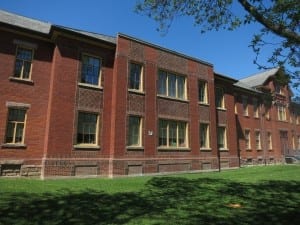
The structure at the middle of the building – it has a different pattern of brickwork, as compared to the older structures – is a section that was added later in order to link up two separate cottages. Extensions are also evident at the left and right ends of the building. Jaan Pill photo
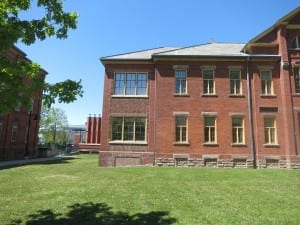
The part of the building that’s on the left in the photo was added some years after the original cottage had been built. Jaan Pill photo
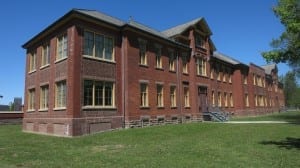
This photo shows the overall structure, with an addition at each end and in the middle. Jaan Pill photo



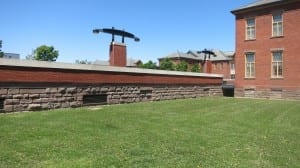

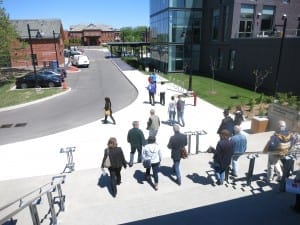
Leave a Reply
Want to join the discussion?Feel free to contribute!